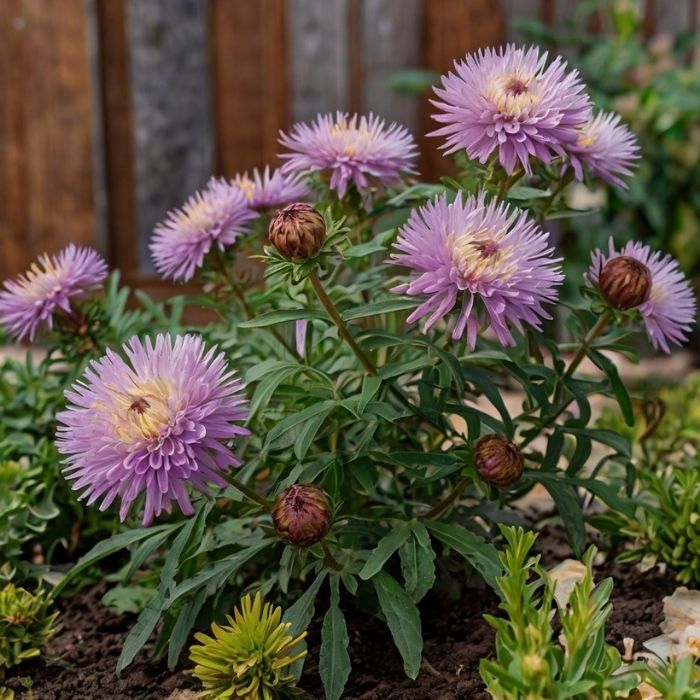A Comprehensive Guide to Aster Flowering: Tips and Insights
Asters are a beloved addition to gardens worldwide, known for their vibrant colors and daisy-like flowers that bloom late in the growing season. These perennial plants are a gardener’s delight, offering a burst of color when most other blooms have faded. Whether you’re an experienced gardener or a budding enthusiast, understanding aster flowering is key to maximizing their beauty in your garden.
In this guide, we’ll explore everything you need to know about asters, including their characteristics, flowering habits, care tips, and common challenges.
What Are Asters?
Asters, belonging to the Asteraceae family, are native to North America, Europe, and Asia. Their name is derived from the Greek word “aster,” meaning star, which aptly describes the star-like shape of their flowers. Asters come in various hues, such as purple, blue, pink, and white, often featuring a striking yellow center.
Popular Varieties of Asters
- New England Aster (Symphyotrichum novae-angliae): Tall and robust, with rich purple or pink blooms.
- New York Aster (Symphyotrichum novi-belgii): Compact and available in an array of colors.
- Smooth Aster (Symphyotrichum laeve): Known for its smooth leaves and pastel flowers.
- Wood’s Aster: A low-maintenance variety ideal for borders.
When Do Asters Flower?
Asters are renowned for their late-season bloom, typically flowering from late summer to early fall. Depending on the variety and growing conditions, their blooms can last for weeks, extending the beauty of your garden well into autumn.
Factors Influencing Aster Flowering
- Light Exposure: Asters thrive in full sun, requiring at least six hours of direct sunlight daily.
- Climate: They prefer temperate climates with moderate humidity.
- Soil Quality: Well-draining, loamy soil enriched with organic matter promotes healthy flowering.
How to Encourage Aster Flowering
Achieving a lush display of aster blooms requires attention to their care and growing conditions. Follow these tips to ensure your asters reach their full flowering potential:
1. Proper Planting
- Timing: Plant asters in the spring to give their roots ample time to establish before the flowering season.
- Spacing: Space plants 1–3 feet apart to allow for air circulation and prevent fungal diseases.
2. Watering
Asters prefer consistent moisture but dislike waterlogged soil. Water them deeply once a week, increasing frequency during dry spells.
3. Fertilizing
Feed asters with a balanced, slow-release fertilizer in early spring. Avoid over-fertilizing, as excessive nitrogen can lead to lush foliage at the expense of flowers.
4. Pruning
Deadhead spent blooms to encourage continuous flowering and maintain the plant’s appearance. Cut back stems in late fall to prepare for winter dormancy.
Common Challenges with Aster Flowering
Despite their resilience, asters can face several issues that impact their flowering. Here’s how to address them:
1. Powdery Mildew
- Symptoms: A white, powdery coating on leaves.
- Solution: Improve air circulation, avoid overhead watering, and use a fungicide if necessary.
2. Lack of Blooms
- Cause: Insufficient sunlight or overcrowding.
- Solution: Relocate asters to a sunnier spot or thin out crowded plants.
3. Pest Infestations
- Culprits: Aphids, spider mites, and lace bugs.
- Solution: Use insecticidal soap or neem oil to control pests.
Companion Planting with Asters
Asters pair beautifully with other late-blooming plants, enhancing the overall appeal of your garden. Consider planting them alongside:
- Goldenrod: Contrasts with asters’ purple and blue tones.
- Sedum: Adds texture and complements the fall color palette.
- Grasses: Ornamental grasses provide a soft backdrop for aster blooms.
The Role of Asters in Pollinator Gardens
Asters are a magnet for pollinators, including bees, butterflies, and moths. Their late-season blooms provide essential nectar and pollen, supporting these creatures as they prepare for winter. By planting asters, you contribute to biodiversity and the health of your local ecosystem.
Overwintering Asters
Asters are hardy plants, but proper winter care ensures their return the following season. After the first frost:
- Cut back stems to about 2 inches above the soil.
- Apply a layer of mulch to insulate the roots.
- Avoid watering during dormancy to prevent root rot.
Incorporating Asters into Your Garden Design
Asters are versatile and can be used in various ways to enhance your garden:
- Borders and Edges: Their compact varieties are perfect for defining garden edges.
- Wildflower Gardens: Asters blend seamlessly into naturalized landscapes.
- Cut Flower Arrangements: Their vibrant blooms add charm to bouquets and floral displays.
Conclusion
Asters are more than just late-season flowers; they’re a testament to nature’s ability to dazzle even as the growing season winds down. With their vibrant hues, ease of care, and pollinator-friendly nature, asters deserve a place in every garden. By following the tips outlined in this guide, you can enjoy a stunning display of aster blooms year after year. Aster Flowers: How to Grow, Care for, and Enjoy These Starry

